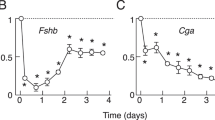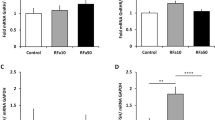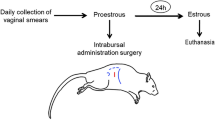Abstract
Although gonadotropin-releasing hormone (GnRH) is believed to mediate the hypothalamic control of pituitary gonadotropin secretion, continuous or repeated administration of GnRH or its agonist analogues has been shown to cause paradoxical anti-fertility effects in several species, including primates1–8. GnRH-induced interruption of reproductive cycles and pregnancy is associated with diminished progesterone production, implying defective function of the corpus luteum1,3–6. These luteolytic effects have been attributed4,5 to the well recognised desensitising actions of elevated luteinising hormone (LH) levels on ovarian LH receptors and steroidogenesis9,10, subsequent to GnRH-induced gonadotropin release from the anterior pituitary. However, treatment with high doses of exogenous LH did not cause suppression of serum progesterone levels during early pregnancy in rat8, whereas a highly active GnRH analogue was effective in this regard. These observations suggested that GnRH and its agonist analogues, given in high or sustained doses, can exert a direct action on the ovary that is independent of the pituitary. This hypothesis was further supported by the ability of GnRH and its agonists to inhibit human chorionic gonadotropin (HCG)-induced ovarian and uterine weight gain in hypophysectomised rats11 and to delay the onset of puberty in intact female rats12. Also, GnRH and its agonist analogues have recently been shown to inhibit steroidogenesis induced by follicle-stimulating hormone (FSH) in cultured granulosa cells, confirming the direct action of such peptides on the ovarian follicle13. The marked inhibitory effects of GnRH and its agonists on corpus luteum function suggest that these compounds could exert direct actions by binding to specific receptors on luteal cells. The present experiments, which examine the effects of GnRH agonists on luteal steroidogenesis, demonstrate the existence of such actions and their mediation by specific high-affinity receptor sites present in luteal cell membranes.
This is a preview of subscription content, access via your institution
Access options
Subscribe to this journal
Receive 51 print issues and online access
$199.00 per year
only $3.90 per issue
Buy this article
- Purchase on Springer Link
- Instant access to full article PDF
Prices may be subject to local taxes which are calculated during checkout
Similar content being viewed by others
References
Corbin, A. et al. Int. J. Pert. 23, 81–92 (1978).
Corbin, A. et al. Fen. Steril. 28, 471–475 (1977).
Rivier, C., Rivier, J. & Vale, W. W. Endocrinology 103, 2299–2305 (1978).
Kledzik, G. S., Cusan, L., Auclair, C., Kelly, P. A. & Labrie, F. Pert. Steril. 29, 560–565 (1978).
Cusan, L. et al. Endocrinology 104, 1369–1376 (1979).
Nillius, S. J., Bergquist, C. & Wide, L. Contraception 17, 538–545 (1978).
Lemay, A., Labrie, F., Ferland, L. & Raynaud, J.-P. Fert. Steril. 31, 29–34 (1979).
Yoshinaga, K. in Ovarian. Follicular and Corpus Luteum Functionss (eds Channing, C. P., Marsh, J. & Sadler, W. A.) 729–734 (Plenum, New York, 1979).
Conti, M., Harwood, J. P., Hsueh, A. J. W., Dufau, M. L. & Catt, K. J. J. biol. Chem. 251, 7729–7731 (1976).
Conti, M., Harwood, J. P., Dufau, M. L. & Catt, K. J. Molec. Pharmac. 13, 1024–1032 (1977).
Rippel, R. H. & Johnson, E. S. Proc. Soc. exp. Biol. Med. 152, 432–436 (1976).
Johnson, E. S., Gendrich, R. L. & White, W. F. Fert. Steril. 27, 853–860 (1976).
Hsueh, A. J. W. & Erickson, G. F. Science 204, 854–855 (1979).
Clayton, R. N., Shakespear, R. A., Duncan, J. A. & Marshall, J. C. Endocrinology (in the press).
Marshall, J. C. & Odell, W. D. Proc. Soc. exp. Biol. Med. 149, 351–355 (1975).
Devilla, G. O., Roberts, K., Weist, W. G., Mikhail, G. & Flickinger, G. J. clin. Endocr. Metab. 35, 458–460 (1972).
Author information
Authors and Affiliations
Rights and permissions
About this article
Cite this article
Clayton, R., Harwood, J. & Catt, K. Gonadotropin-releasing hormone analogue binds to luteal cells and inhibits progesterone production. Nature 282, 90–92 (1979). https://doi.org/10.1038/282090a0
Received:
Accepted:
Issue Date:
DOI: https://doi.org/10.1038/282090a0
This article is cited by
-
Immunohistochemical localization of gonadotropin-releasing hormone receptors (GnRHR) in the nervous system, Hatschek’s pit and gonads of amphioxus,Branchiostoma belcheri
Chinese Science Bulletin (1999)
-
GnRH receptors and GnRH endocrine effects on luteoma cells
Endocrine (1997)
-
GnRH in pregnancy
Archives of Gynecology and Obstetrics (1996)
Comments
By submitting a comment you agree to abide by our Terms and Community Guidelines. If you find something abusive or that does not comply with our terms or guidelines please flag it as inappropriate.



